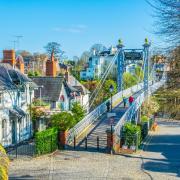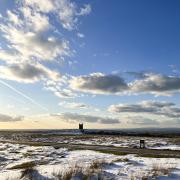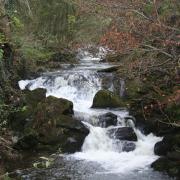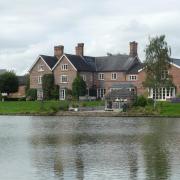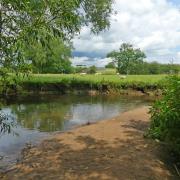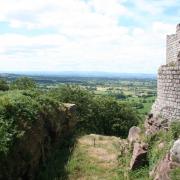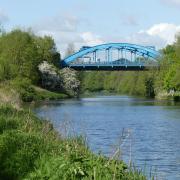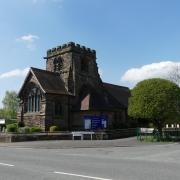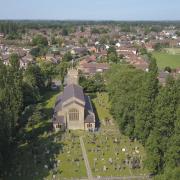From the sandstone walls of what was once a great Roman fortress to the many medieval timbered buildings that remain today Chester is a hotbed of history.

When Hugh Lupus, the nephew of William the Conqueror, came to Chester as the first Earl of the city he brought with him Benedictine monks from Normandy and almost immediately he began to rebuild the earlier church on a much grander scale, creating an abbey that continued under the control of the Benedictine order until the Dissolution of the Monasteries between 1536 and 1541.
It was at this time that King Henry VIII converted the abbey into the cathedral church under the newly formed diocese of Chester in 1541. The cathedral we see today was modernised by Sir Gilbert Scott starting in 1868 and the exterior almost completely recased in new sandstone at that time.
However, I wonder how many visitors to Chester are aware that an earlier cathedral had existed in the city, rising proudly from a red sandstone cliff on the north bank of the river Dee on the site where a Saxon minster was destroyed during the Norman conquest around the year of 1069.
The first Cathedral of Chester, known as the Church of St John the Baptist was the Cathedral and Collegiate church for Chester from 1075 through until the Reformation. In 1541, the Bishop's seat was transferred to the nearby dissolved abbey of St Werburgh, which is the cathedral you see today.
That original edifice – St John’s – is still very active and a visit here to absorb this iconic historical jewel with its stunning medieval architecture is a must if you are making the journey to Chester.

The church has a rich and varied history dating back over a thousand years and remains one of the major parish churches of England. In this year of the Platinum Jubilee of Queen Elizabeth II, it’s interesting to see that in the north aisle of St John’s, upon the west wall, the many shields of arms, including one for the daughter of Alexander Coates. Coates held office in the court of Queen Elizabeth I and as a result, his daughter was appointed a maid of honour to the queen.
Alongside the church we see today are the remains of the eastern chapels believed to have fallen into ruin shortly after the College of Canons was dissolved soon after 1541 and it is in these ruins that many important carved stones were recovered in the Victorian period, and more recently during further excavations carried out by archaeology students from the University of Chester, telling us more about the ancient history of this site.
During Victorian times the very best carved stones were stored in the Chapter House while other carved stones were placed inside the northwest tower of St John’s.
These wonderful carvings include circle-headed crosses of the 9th and 10th centuries, often attributed to the Viking age and very similar to other ones found on the Wirral and northeast Wales.
Other stones that have been recovered from the ruins include Romanesque architectural stones belonging to the earliest period of the Norman church, from the late 12th to mid-14th century. It was at this time that St John’s had reached its greatest height of importance.

Another stunning stone carving recovered is a sandstone statue of an elderly bearded man believed to be that of the patron of the church St John the Baptist. Originally stored in the Chapter House, it was transferred to the church where it could be preserved and displayed properly.
Also on display is a half-effigy of Lady Agnes de Ridlegh who died on the 30th of April 1347. The upper part of her body is clearly shown however the lower part is covered beneath a coffin lid decorated with a tree with finely carved leaves. Her husband was Richard de Ridlegh, at that time a sheriff of Chester. This half-effigy representing a woman is unique in the County of Cheshire.
An effigy of a knight is believed to be a member of the de Carrington family who had strong links with the church during the 14th century. Three members of the de Carrington family are known to have served in France as part of an attempt by Richard II to hold onto lands there.
Along the north aisle lays a collection of secular stones providing an insight into the life and society of Chester during medieval times and beyond, and highlighting the high status of the medieval church.

One of the secular stones represents John the Sergeant who was a sergeant at arms. A sword is carved upon his stone along with an inscription. Other secular stones on display belong to a blacksmith and a glover, with carvings of the tools of his trade.
The church is a site of huge historical, archaeological and architectural importance and work continues by archaeology students from the University of Chester to investigate the environs of the St John’s site in Grosvenor Park as part of their graduate course.
Meanwhile, Chapel Archaeology is carrying out resistivity tests in the churchyard to look for further remains of the many chapels and buildings that once occupied the site.
Many of my films highlighting the history of Cheshire churches can be viewed for free with many other local history films by visiting my channel, youtube.com/Tvpresenter4history.

Things to look out for
The ruins of the eastern chapels to the side of St John’s Church
The circle-headed stone crosses dated to the 9th–10th century
The sandstone statue of St John the Baptist displayed in the north aisle
The medieval secular tombstones of the sergeant, blacksmith and glover






